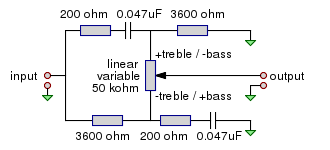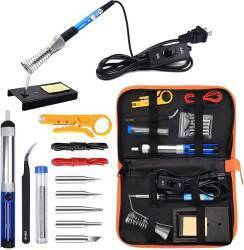
A Simple Audio Tone Control Circuit
Audio Tone Control
This very simple passive circuit provides
a simple audio shaping function.
It was described by Derek Bowers in
Electronic Design in February, 2012.
At the center of its range, its response is flat across the
audio spectrum.
Adjusted away from center in one direction,
it boosts signals above 1 kHz while attenuating those
below 1 kHz.
Adjusted in the opposite direction, vice-versa.
The circuit needs to be driven by a low-impedance stage, something 100Ω or less, and followed by a high-impedance stage, 250kΩ or more. Since it produces a flat 6 dB insertion loss at the tone control's center position, it would make sense to follow this with a high-impedance op amp based gain stage providing at least the recovery of the 6 dB.

For the 300-3300 Hz audio bandwidth of typical ham systems, at the extreme positions of the control it provides about 5.5 dB of boost and about 6 dB of cut.
Much more complex audio processing circuits are frequently used, but this has a low parts count supported by typical junk boxes. You could scale this design by multiplying all resistor values by a common factor while dividing all capacitor values by that same factor (with some slop to use standard values). For example, 100Ω and 1800Ω resistors and 0.1 uF capacitors.
With lower resistor values you will need even an input stage with an even lower impedance. One simple rule of thumb would be to keep the impedance of the driving stage below half that of the smaller resistor value, and the impedance of the following stage above half that of the variable resistor.
The variable resistor should be a linear one, and ideally it would have a center detent.
